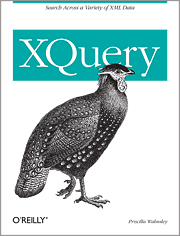fn:resolve-uri
Resolves a relative URI to a base URI, returning an absolute URI
Description
The fn:resolve-uri function takes a base URI ($base) and a relative URI ($relative) as arguments, and constructs an absolute URI.
If $base is not provided, the base URI of the static context is used. This may have been set by the processor outside the scope of the query, or it may have been declared in the query prolog.
This description is © Copyright 2007, Priscilla Walmsley. It is excerpted from the book XQuery by Priscilla Walmsley, O'Reilly, 2007. For a complete explanation of this function, please refer to Appendix A of the book.
Arguments and Return Type
| Name | Type | Description |
|---|---|---|
$relative |
xs:string? |
the relative URI |
$base |
xs:string |
the base URI to resolve it to |
| return value | xs:anyURI? |
Examples
| XPath Example | Results | |
|---|---|---|
resolve-uri('prod', 'http://datypic.com/') |
http://datypic.com/prod |
|
resolve-uri('prod2',
'http://datypic.com/prod1') |
http://datypic.com/prod2 |
|
resolve-uri(
'http://example.org','http://datypic.com') |
http://example.org |
|
resolve-uri(
'http://datypic.com', '../base') |
http://datypic.com |
|
resolve-uri(
'', 'http://datypic.com') |
http://datypic.com |
|
The following examples assume that the base URI of the static context is http://datypic.com: | ||
resolve-uri('prod') |
http://datypic.com/prod |
|
resolve-uri('') |
http://datypic.com |
|
See Also
| fn:base-uri | The base URI of a node |
| functx:is-absolute-uri | Whether a URI is absolute |
| fn:encode-for-uri | Encodes reserved characters for use in the path of a URI |
History
| Published On | Last Updated | Contributor(s) |
|---|---|---|
| 2006-06-27 | 2007-02-26 | W3C, XQuery 1.0 and XPath 2.0 Functions and Operators, http://www.w3.org/TR/xpath-functions/ |

